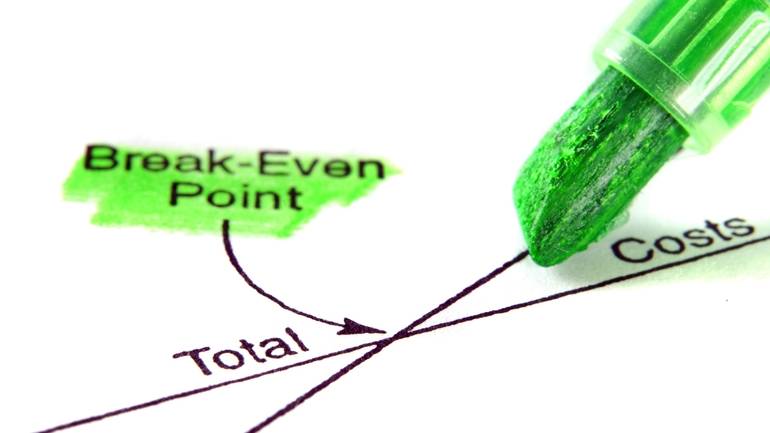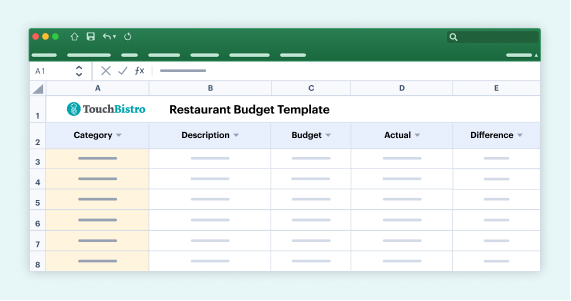Knowing your numbers, including your break-even point, is a critical part of running a financially viable restaurant. Your restaurant can have a James Beard Award and tables filled with customers, but if it’s spending more than it’s bringing in, the business will inevitably fail.
Novice restaurateurs may be surprised to learn just how much math is involved in running a successful restaurant. You have to calculate the cost of goods sold to set menu prices. You have to keep an eye on labor spending to ensure overtime isn’t biting into your profits. You also have to run a break-even point analysis to ensure your restaurant is financially healthy.
In this guide to the break-even formula, we’re explaining:
- Why doing a restaurant break-even analysis is vital
- Common terms related to the break-even point formula
- How to calculate a break-even point for your restaurant
- How to use a break-even analysis to make business decisions
Break-Even Formula 101: Why Knowing Your Break-Even Point Is Crucial to Restaurant Success
Conducting a restaurant break-even analysis helps you determine how much you need to sell so that your business’ expenses match its revenue. This is one of the most critical restaurant KPIs to measure, because your break-even point enables you to understand how well your restaurant is doing financially.
Your restaurant could be generating $100,000 each month in revenue, which sounds impressive. But if you do a break-even analysis, you might find out that your restaurant spends $200,000 each month and needs to double or triple its revenue to be profitable.
When you know your restaurant’s break-even point, you can set realistic prices and sales goals to make up for your spending and turn a profit.
Break-Even Formula Glossary
Here are several terms you need to know to use the break-even formula successfully.
What is a break-even point?
A break-even point is the spot at which a business earns as much money as it spends. In other words, a restaurant reaches its break-even point when it has a $0 net profit; thus, its revenue and expenses are equal.
What is a break-even analysis?
A break-even analysis is the exercise of calculating your break-even point to find out how much money your business needs to generate or how many units it must sell before it starts becoming profitable.
What is the break-even formula?
The break-even formula helps you find your restaurant’s break-even point. You can calculate it in units sold or sales dollars generated.
The formula for break-even point by units sold is:
Break-Even Point by Units Sold = Sum of Recurring Costs / Contribution Margin
And the formula for break-even point by sales dollars is:
Break-Even Point by Sales Dollars = Sum of Recurring Costs / Contribution Margin Ratio
We’ll break these formulas down in the next section.
How to Calculate Your Restaurant’s Break-Even Point

Here’s how to use the two break-even point formulas to uncover critical business insights.
Pro tip: Use your POS reports to find key components of these formulas, instead of calculating them manually.
How to Use the Break-Even Formula to Find Your Restaurant’s Break-Even Point by Units
So, what do we mean by break-even point by units?
This figure reveals how many units of a specific menu item (e.g. scoops of ice cream) you have to sell to reach a $0 net profit. Calculating break-even point by units, rather than by sales dollars, is most useful when your menu has only a few items on it.
Sandwich shops, pizza parlors, and ice cream shops are examples of venues that might use the formula for break-even point by units.
Choose a period of time over which you’d like to know your break-even point. For example, if you calculate your monthly break-even point, you’re learning how many units you have to sell in one month to earn as much as you spend in one month.
Break-Even Formula by Units Sold = Sum of Recurring Costs / Contribution Margin
Expanded Formula: Recurring Costs / (Revenue Per Unit – Cost Per Unit)
To find your sum of recurring costs, add up regular expenses your restaurant owes, like rent or mortgage payments, salaries and wages, restaurant insurance, inventory, and utilities. Check your POS reports to find these expenses more easily. If you’re calculating your monthly break-even point, determine how much you spend on these things during a month.
To find your contribution margin, subtract your cost per unit from your revenue per unit. Revenue per unit is how much you charge customers for the item that you’re calculating a break-even point for, like a scoop of ice cream. Cost per unit is how much that item costs you to make. You can find your cost per unit in your POS reports. To calculate this figure manually, add up the ingredients’ costs for one unit of the menu item in question.
Let’s put this formula into practice. You own a sandwich shop and want to figure out how many sandwiches you need to sell each month to break even.
First, you find your recurring costs per month. After adding up your monthly inventory costs, rent, utilities, labor, and other expenses, you discover that your restaurant has $25,000 in monthly expenses.
Next, you identify your revenue per unit and cost per unit to calculate your contribution margin. You charge customers $10 for a sandwich, so that’s your revenue per unit. You look up your per-unit costs POS report and find that two slices of bread, three ounces of deli meat, two slices of cheese, and a dollop of mayo costs your shop $3. You subtract the cost per unit cost from revenue per unit ($10 – $3) and find out that your contribution margin is $7 per sandwich.
Then you divide your recurring monthly expenses by your contribution margin ($25,000 / $7) and learn that you have to sell 3,571 sandwiches each month to break even.
25,000 / (10 – 3) = 25,000 / 7 = 3,571
How to Use the Break-Even Formula to Calculate Your Restaurant’s Break-Even Point by Sales
The break-even point by sales dollars formula reveals how much revenue your restaurant must generate to break even. This exercise is more useful than finding out how many units you need to sell if your restaurant has a varied menu.
Break-Even Point by Sales Dollars = Sum of Recurring Costs / Contribution Margin Ratio
Expanded formula: Recurring Costs / [(Average Revenue Per Unit – Average Cost Per Unit) / Average Revenue Per Unit]
Just like in the previous formula, to find the sum of recurring costs, you need to add up your restaurant’s regular expenses, like rent, wages, and inventory costs.
Don’t confuse contribution margin with contribution margin ratio. The contribution margin ratio involves dividing the contribution margin by revenue per unit.
To find your contribution margin ratio, you’ll first need to calculate your contribution margin. You’re going to calculate contribution margin differently than you did for the break-even point per sales dollars formula.
You’ll use the average revenue per unit and the average cost per unit, rather than revenue per unit and cost per unit, because you want to know cost and revenue for the entire menu, rather than just for one item. Look at your POS reports to find these figures.
So, find your contribution margin by subtracting the average cost per unit from the average revenue per unit. Next, find your contribution margin ratio by dividing your contribution margin by your average revenue per unit.
Let’s apply the break-even formula per sales dollars to the sandwich shop example. You want to find out how much revenue you need to generate each month to break even.
You already know from the last example that your sandwich shop’s monthly recurring expenses are $25,000.
Besides sandwiches, your shop also sells chips and drinks. You look at POS reports and learn that your average revenue per unit is $7 (your average menu price), and your average cost per unit is $2 (the average amount it costs your shop to make sandwiches or purchase chips and drinks).
Now you can plug those numbers into the break-even formula per sales dollars:
25,000 / [(7 – 2) / 7] = 25,000 / (5 / 7) = 35,000
You find out that you need to generate $35,000 in monthly sales to break even.
4 Ways to Use a Restaurant Break-Even Analysis

Knowing your restaurant’s break-even point can help you set goals to reach your break-even point and eventually make a profit.
Here are four ways to use a break-even point restaurant analysis to achieve business success.
1. Set Sales Goals
Knowing your break-even point can help you set sales goals based on data rather than just a gut feeling or historical sales figures. For example, if you sold 10,000 sandwiches this time last year, but your expenses have since gone up, then setting a goal to sell 10,000 sandwiches isn’t useful.
While the sandwich shop examples mentioned earlier calculated the break-even point on a monthly basis, you can also calculate it on a weekly, quarterly, or annual basis to set sales targets.
2. Set Menu Prices
Conducting a break-even analysis reveals how many units or sales you need to make to break even. If your sales goals seem unattainable, there’s no need to fret. Rather than increasing the number of units you sell, you can also increase your menu items’ prices or decrease the cost per unit.
For example, rather than selling sandwiches for $10, you could charge $13 for them, which will bring you closer to your revenue goals. And if you decrease your cost per unit from $3 to $2 by reducing portion sizes or finding cheaper vendors, you can reach your break-even point even faster.
$25,000 / ($13 – $2) = $25,000 / $11 = 2,272 sandwiches
Suppose you run a per unit break-even analysis with $13 as your revenue per unit and $2 as your cost per unit with $25,000 in recurring expenses. In that case, you have to sell 2,272 sandwiches rather than 3,571 sandwiches (based on when your revenue per unit was $10 and your cost per unit was $3) each month to break even. That’s nearly 1,300 fewer sandwiches you have to sell each month!
3. Manage Expenses
Another way to break even more quickly is to reduce your recurring expenses. While some costs are fixed, like rent payments, others are varied. Audit your most significant variable expenses and find ways to reduce those costs.
For example, labor is one of the greatest variable expenses for restaurants. Restaurants typically spend 30.5% of their revenue on salaries and wages.
Look at your POS to audit your labor spending. How often are you overstaffed? Can you cut down on overtime? Can you give servers side duties that can make you spend less on back of house staff?
When you decrease your recurring expenses, you can reach your break-even point more quickly.

Stay on top of expenses and manage costs with this restaurant budget template for Excel or Google Sheets.
A restaurant is first and foremost a business and needs to be treated as such to stay open for the long term. A break-even point restaurant analysis can unlock powerful insights into your business’ financial health and help you plan for its longevity.
Download our free inventory template
Sign up for our free weekly TouchBistro Newsletter







